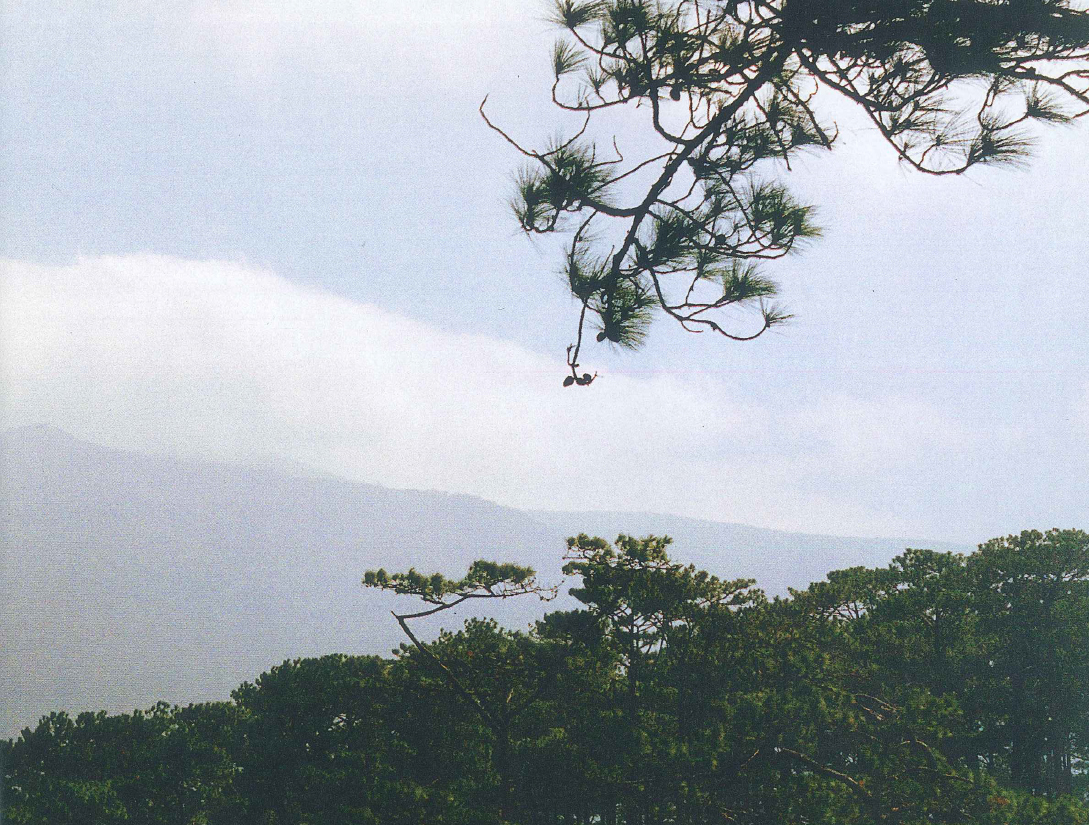
In the Cardamom Mountains of southwest Cambodia, the rain forest grows thick. During monsoon season, a canopy of phayom, rosewood, pinang baik, and white meranti trees blocks out the sun. At night, the forest emits its own soft orange light, as hunters burn campfires to ward off elephants.
“It’s seriously rough country, a wild and beautiful place,” says Brendan M. Buckley, a Columbia scientist who led a research expedition here in January. “You move slowly, bashing and slashing your way through the vegetation.”
Buckley is here because he thinks these woods, which are among the most remote in Asia, hold secrets to the disappearance of a city that once existed in the jungle some 100 miles north of the mountains. This was the city of Angkor, which, at its pinnacle in the 12th century, was home to 750,000 people and covered some 400 square miles — the largest footprint of any urban development in the preindustrialized world. Its workers built gigantic Hindu temples out of sandstone and planted rice paddies that stretched far over the horizon. Its engineers created dams and reservoirs to irrigate crops, even waterways to travel around the settlement by boat.
And then this civilization vanished. By the time Portuguese missionaries arrived in the 16th century, the city had been largely abandoned and its temples enshrouded in vegetation.
What happened to Angkor? “There are few written accounts that have survived from the period, so it’s an enduring mystery,” says Victor Lieberman, a professor of Southeast Asian history at the University of Michigan. “We historians don’t have much evidence to grasp onto.”
But that’s changing now that Buckley is discovering new clues — not in stone carvings or long-lost travelogues, but in the flesh of evergreen trees.
The scent of conifer
Climbing up a ridge in the Cardamoms, Buckley spots a cluster of evergreens known as Dacrycarpus imbricatus, a rare species with no common name in English. With their needle-shaped leaves and shrubby limbs, the trees look out of place in a rain forest.
“Even in the tropics, we find evergreens in the highest, coolest altitudes,” says Buckley, an associate research professor at Columbia’s Tree-Ring Laboratory. “We look for evergreens because they show their growth rings clearly. They’re prized for their soft lumber, too, so we have to go into remote areas to find any old ones still standing. These here are really nice — maybe 500 years old.”
Buckley unzips his knapsack and removes a wood borer, a hand-operated drill with an extremely long, hollow bit. He presses the borer gently into the side of a tree, aiming it straight for the core. Then, gripping the borer’s T-shaped handle with both hands, Buckley leans into the tree and begins rotating the tool as if it were a tire iron. With each half-turn, the scientist lets out a grunt and the wood produces a nasal, birdlike squawk. The oily, slightly floral scent of conifer wafts in the air. After 15 minutes (“I’ve had bursitis in both elbows”), Buckley stops, the borer having disappeared almost entirely into the tree. He inserts a tiny spoon into the back of the tool’s hollow bit and pulls out a long beige dowel partitioned by some 450 orange stripes — a chronicle of this tree’s life.
“These rings hold a lot of secrets,” he says. “Not just the tree’s age, but also its annual growing conditions. In a year when there’s little rain, you’ll get a skinny ring.”
Since the mid-1990s, Buckley has collected cores from thousands of trees across Cambodia, Vietnam, Thailand, and Laos, generating insights into the region’s climate history that could have been achieved no other way: Just as ice cores provide a glimpse of past atmospheric conditions and coral reefs indicate historic ocean temperatures, tree rings document annual precipitation levels.
And it doesn’t hurt the tree. After Buckley takes a core, he doesn’t even need to plug up the hole. “It’s actually better for the tree if you don’t plug it,” he says. “Trees are very good at compartmentalizing their wounds, which means they physically and chemically wall off the injured area to prevent pathogens from seeping in.”
Over the course of this three-day field expedition, Buckley will collect dozens of cores, slide each one into a clear plastic tube that resembles an oversized drinking straw, and ship them to his lab at the Lamont-Doherty Earth Observatory, in Palisades, New York. Once he’s back at the lab, he will sandpaper each core until it’s shiny smooth, which enables him to take microscopic measurements of its rings. Then, by analyzing the rings from many trees of the same species — looking for years in which all of the trees grew a skinny ring or a wide ring, for instance — he will identify common patterns in their year-to-year growth variations. With this information, he can estimate past rainfall levels.
“Weather stations started taking routine measurements of rainfall in this area in 1951,” Buckley says. “So we start by correlating the newest tree rings against these precise rainfall measurements. Then, we can extrapolate backward into the distant past, based simply on the rings.”
Buckley didn’t start this work with Angkor in mind. As a climate scientist, he has always had a broader goal: to help fellow scientists design computer models that can predict future rainfall patterns in Asia, based on past monsoon cycles. He has already made important contributions in this area, showing, for instance, that when water temperatures in the Pacific and Indian Oceans have changed over the past millennium, monsoons have typically been disrupted, triggering wild variations in the amount of rainfall they bring.
A few years ago, however, Buckley, who is widely regarded as the foremost tree-ring researcher working in the Asian tropics, started receiving phone calls from historians and archaeologists. Word had spread that he was routinely coring trees as old as 750 years, dating back to Angkor’s heyday. Soon, Buckley was collaborating with archaeologist Roland Fletcher, a professor at the University of Sydney and an expert on Angkor’s medieval civilization. Buckley began looking for old-growth forest as near as possible to Angkor and helping his colleague interpret the data.
Their big discovery came last spring, when Buckley, Fletcher, and fellow Columbia tree-ring specialists Edward Cook and Kevin Anchukaitis published a paper showing that Angkor, during the century before it is thought to have collapsed, experienced two long and severe droughts. The first lasted an astonishing 30 years, the next 20 years. Each of these dry periods was punctuated by several years of heavy monsoons that, according to Buckley, likely caused devastating floods.
“We’re talking about dry spells the likes of which we’ve never seen in modern history,” he says. “And then, the skies open up and the rain won’t stop.”
Partial histories
That discovery, published in the Proceedings of the National Academy of Sciences, has provided the most compelling evidence yet for a theory that most scholars, until now, have dismissed as overly speculative: that climate change contributed to Angkor’s collapse. Other, more subtle clues had been found before. A few years ago, Fletcher and his team of archaeologists unearthed evidence that Angkor’s main reservoir was retrofitted around the same time the city is thought to have collapsed, in the early 15th century, to be just half of its original size. The archaeologists hypothesized that this renovation was undertaken during a prolonged drought to ensure that water coming into the reservoir from a nearby river would accumulate rather than seep into a big, half-empty mud basin.
“There are also accounts of drought in China and in India around this same time,” says Lieberman, the historian at Michigan. “It would stand to reason that Angkor might have had extreme weather, too.” This was a period when the Earth was undergoing a major climate shift, scientists believe, as it was transitioning from what’s commonly called the Medieval Warm Period into the Little Ice Age.
Few historians have considered climate change’s effects on Angkor, however. The standard explanation for Angkor’s demise, Lieberman says, is that its ruling elite simply abandoned the city when economic activity in Southeast Asia shifted southward toward coastal ports in the 14th century. Other scholars say that Angkor’s political structure disintegrated when Buddhism swept through the region in the 13th century, as Angkor’s rulers considered themselves earthly representations of Hindu gods.
Lieberman stands alone among prominent historians in that he has suggested for years that climate change hastened Angkor’s collapse. “The evidence that Angkor saw severe drought was rather circumstantial before Brendan generated this rainfall data, but I still thought it was the best prima facie explanation we had,” he says. “Other historians haven’t looked at this issue closely, I think, in part because they don’t feel comfortable with their own understanding of the science. So, in the absence of any written accounts of drought or flooding near Angkor, they’ve preferred to focus on the types of phenomena they’re accustomed to writing about, which are the economic, political, and cultural factors.”
Now, with Buckley’s findings, Lieberman believes that historians are obligated to study how Angkor, as well as several other historic Southeast Asian civilizations, were affected by extreme weather. He points out that Buckley’s data reveal prolonged droughts also occurred between 1638 and 1641, just three years before peasant rebellions led to the fall of the Ming Dynasty, and between 1756 and 1768, around the same time that three kingdoms in what are now Vietnam, Myanmar, and Thailand all collapsed. In a forthcoming essay coauthored with Buckley, Lieberman exhorts fellow historians to examine why certain civilizations succumbed to these droughts while others survived. The answers might lie, they say, in the societies’ water-management strategies, the nature of their governments, and the diversification of their economies.
“For the first time,” Lieberman and Buckley write, “we have the data to make climate change a part of our regional narrative.”
Archaeologists, meanwhile, say that Buckley’s work is helping them justify further research on Angkor’s water-management system. Fletcher is now studying the remains of a stone dam built across the Siem Reap River to fill the reservoir that was renovated near the city center. “It looks like the dam was obliterated suddenly at some point, which we can tell by the way its remains are distributed in the riverbed,” he says. “It looks like there was a deluge.”
In a forthcoming book about Angkor, Fletcher lays out this hypothesis: The city had grown so sprawling by the 14th century, and its infrastructure so large and unwieldy, that its citizens couldn’t alter dams, reservoirs, and irrigation ditches quickly enough when the monsoons went haywire.
“When the rains were light, these people had to figure out how to collect every drop of water,” Fletcher says. “And when the monsoons got really heavy again, any infrastructure that had been renovated to accommodate the dry periods could have been torn apart. If this kept happening, the people would have lost faith in their rulers.”
Water for tomorrow
Today, Buckley and other Columbia tree-ring scientists, including Edward Cook, his son Ben Cook, Kevin Anchukaitis, and Rosanne D’Arrigo ’89GSAS, continue to sample trees throughout Southeast Asia. Among their goals is to improve the integrity of the rainfall data that form the basis of the Angkor drought study. They also want to expand their geographic coverage — they’ve sampled trees from 300 locations in India, Nepal, Myanmar, China, Japan, as well as in Southeast Asia, so far — to determine where droughts have been most severe over the past millennium.
“Ultimately, we want to be able to tell how a drought affected one country versus another in the same region,” says Buckley. “This will give us a detailed understanding of monsoon activity.”
This information, the scientists say, could help governments in the region determine where they ought to construct new reservoirs to prepare for the possibility of severe and prolonged drought. The scientists worry that the summer rains could be disrupted again if global warming causes water temperatures in the Indian and Pacific Oceans to rise. The monsoons, they point out, provide drinking water for hundreds of millions of people year-round, as well as irrigation for their crops.
“One of the powerful things about paleoclimate research is that it shows us what nature is capable of,” says Anchukaitis, who integrates tree-ring information into the computer simulations used by climate modelers. “We may not have any written record of a 30-year drought ever occurring in this area, but it happened once. The trees show that.”


